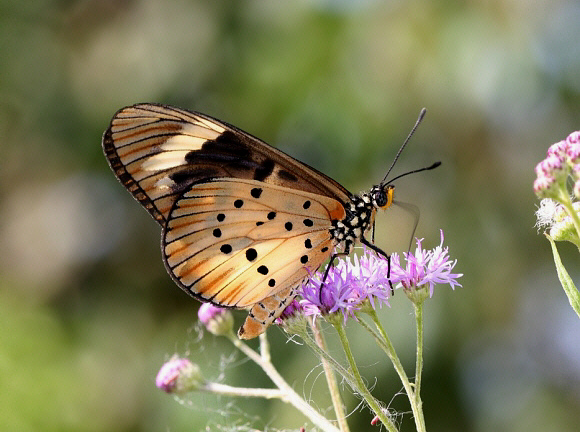
Introduction
There are 228 Acraea species, of which 223 are Afrotropical in distribution. The majority are found in the forests and savannahs of East Africa, while about 60 are found in West Africa. Beyond Africa a further 5 species occur in the Oriental region, and another is found in Australia / New Guinea. In the neotropical region there are 50 additional species, but these are normally placed in the genera Actinote, Altinote and Abananote due to differences in venation and genitalia.
All Acraea species have elongate forewings and rounded hindwings. The wings are thinly scaled and in many species are semi-transparent. The scales wear off very easily so that insects more than 4 or 5 days old have a glassy or greasy appearance. The majority of species have a predominantly brownish or greyish ground colour, marked with bands or patches of red or orange. The basal area of the underside hindwings of most species is marked with a pattern of small black spots. In many, including encedon, these spots also appear on the upper surface of the wings.
Acraea encedon is distributed from Gambia to Ethiopia, Sudan and s.w. Arabia. Its range extends south to Angola, Malawi, Tanzania and Mozambique, and the butterfly also occurs in Madagascar.
This species is very similar to encedana, but has 2 black spots in the discal cell of the hindwing whereas encedana has only one spot. Both species produce colour variants – e.g. in Ethiopia and Sudan the apical bar and hindwings of encedana are pale orange, but elsewhere they are usually white. In encedon the apical bar and hindwings in most parts of its range are a dull dirty orange, but in the mid-elevation Ethiopian form they are a very pale orange.
Habitats
This is a common species found in open savannah country, and can also be seen in cleared areas within the forest zones, and on coastal grasslands and dunes.
Lifecycle
The larval foodplants include Commelina ( Commelinaceae ), Aeschymonene ( Papilionaceae ) and Pouzolzia ( Urticaceae ). On rare occasions Desmodium salicifolium ( Fabaceae ) may be used.
Adult behaviour
Acraea encedon, and its very close relative encedana, are particularly fascinating because both commonly produce all-female broods. Typically over 50% of all broods of encedon are all-female, but a study in Sierra Leone revealed that no less than 95% of the broods analysed were entirely female. The dominance of females has been found to be caused by the selective killing of male embryos by a Wolbachia bacterium.
